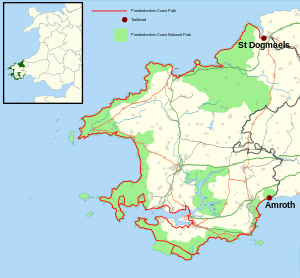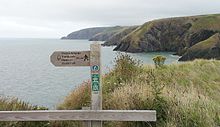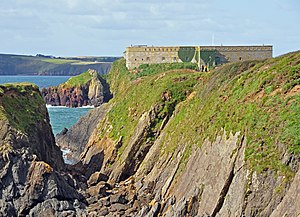Pembrokeshire Coast Path
The Pembrokeshire Coast Path also often called the Pembrokeshire Coastal Path, is a designated National Trail in Pembrokeshire.[1] It was established in 1970, and is 186 miles long, mostly at cliff-top level, with a total of 35,000 ft of ascent and descent. At its highest point – Pen yr afr – it reaches a height of 574 feet, and at its lowest point – Sandy Haven crossing – it is just six feet above low water.[2] Whilst most of the coastline faces west, it offers – at varying points – coastal views in every direction of the compass.
The southern end of the path is at Amroth. The northern end is often regarded as being at Poppit Sands, near St Dogmaels, where the official plaque was originally sited[3] but the path now continues to St Dogmaels,[4][5] where a new marker was unveiled in July 2009.[6] Here the path links with the Ceredigion Coast Path, which continues northwards.[7]
The Pembrokeshire Coast Path forms part of the Wales Coast Path, an 870-mile long-distance walking route around the whole coast of Wales from Chepstow to Queensferry, which was officially opened in 2012.[8]
Contents
History of the path
Following the establishment of the Pembrokeshire Coast National Park in 1952, Welsh naturalist and author Ronald Lockley surveyed a route around the coast. Although there were villages and settlements on the coast, communication between these was largely by boats, and access in the region was generally poor.[9] Lockley's report for the Countryside Commission in 1953 was welcomed and broadly adopted. Some sections of the walk were existing rights-of-way, but the majority were in private hands, necessitating negotiation. Most landowners were in favour, and many benefited from the erection of new fencing. Even today, however, the path in places detours from the obvious line where landowners were unwilling to accept a new right-of-way across their land.[4]
Completion of the path took 17 years, and this work included the erection of more than 100 footbridges and 479 stiles, and the cutting of thousands of steps into steep or slippery sections.[4]
When opened by Wynford Vaughan-Thomas on 16 May 1970, the length of the path was given as 180 miles, but over the years there have been a number of Footpath Diversion Orders which have extended it to its current length of 186 miles.[4]
Description
The Pembrokeshire Coast Path lies almost entirely within the Pembrokeshire Coast National Park — Britain's only coastal national park. Throughout its length it covers a range of maritime landscapes, from rugged and steep limestone cliffs and volcanic headlands to sheltered red sandstone coves, flooded glacial valleys, winding estuaries, and wide-open beaches. The path passes 58 beaches and 14 harbours.[10]
As far as possible the route runs close to the cliff edge and coast, but this is not possible at all times; on occasion the coast is barely in sight where the path briefly detours round industrial or military areas. It does not include any of the coast inland of the Cleddau bridge, missing about 50 miles of coastline around the estuary.
The walking is not strenuous, but there are constant undulations and narrow sections, including many stiles. In its entirety the Coast Path represents a considerable physical challenge — its 35,000 ft of ascent and descent is said to be equivalent to climbing Everest. There are two low-tide crossings, at Dale and Sandy Haven, which require lengthy detours if not timed suitably.
Along the path are seaside towns and coastal villages, such as Tenby, St David's, Solva and Newport. For backpackers attempting longer parts of the trail there are shops and campsites along the way, but food and water may need to be carried on some sections. There are small hotels and guest houses en route, invariably family-run, and cottages for hire, often built in traditional styles.
For the vast majority of walkers, the coastal path is walked in shorter sections, and the Pembrokeshire Coast National Park lists some 130 shorter circular walks on its website.[11] Access to the coastal path (by bus or car) is possible in many locations. The whole coast is served by a number of dedicated walkers' bus services, which operate over the entire length of the path, including the Puffin Shuttle, the Coastal Cruiser, the Celtic Coaster, St David's Peninsula Shuttle Service, the Strumble Shuttle, and the Poppit Rocket.[12]
Since the construction of the Cleddau Bridge across Milford Haven Waterway it is possible to walk the whole route of the trail without a break. The path, however, is not continuous in that it is not designated through built-up areas in the southern section, such as Milford Haven, Pembroke Dock, Tenby and Saundersfoot. There is also an undesignated section between St Dogmaels and Cardigan at the northern end of the path where Cardigan Bridge over the River Teifi is the nearest point to the coast between the Pembrokeshire and Cardiganshire Coast Paths.
Offshoot trails
There are a number of smaller trails very near the Coast Path, which often take users inland on shorter routes; these include:
- Cardigan to Cilgerran Wildlife Trail. The trail runs from Station Road, Cardigan, through Teifi Marshes Nature Reserve, to Cilgerran, passing the Welsh Wildlife Centre and following the trackbed of the former Whitland and Cardigan Railway.[13]
- Cilgerran Gorge Circular Walk. This is a medium-length walk of 4¼ miles lasting around three hours. It starts at Dolbadau car park, Cilgerran and follows the woodland pathway to the Wildlife Centre and returning via undulating paths up and down the steep-sided Cilgerran Gorge.
- Brunel Way Walk. This is a long walk of nine miles on well-surfaced tarmac pathways, lasting around four hours. It begins at Brunel Quay car park, Neyland and ends at County Hall, Haverfordwest. Along the way there are spectacular views of Milford Haven and of the quay, which is home to one of the largest and possibly most beautiful marinas in Wales.
Geology
All the rocks underlying the surface are more than 300 million years old, but the coastline as seen today has been much subjected to the effects of coastal and river action and, in places, to events which occurred during the Ice Age.
The oldest igneous and volcanic pre-Cambrian granites outcrop on Ramsey and at the southern tip of the peninsula. Later Cambrian sedimentation produced sandstones, visible on the northern coast of St Brides Bay (and which were used in the building St David's Cathedral). Subsequent Ordovician fine muds dominate the northern Pembrokeshire coast, but volcanic activity has complicated the whole. The later Silurian Period saw the creation of limestone and shale, visible along the southern Marloes peninsula.[9]
Subsequent earth movements, erosion by ice and water, and changes in sea level have further affected what we see today.
Wildlife
During the spring and early summer the path displays an array of wild coastal flowers, and there is a wealth of bird life. Colonies of seabirds nest along the cliffs, and a huge variety of European seabirds are supported by the uninhabited offshore islands that act as bird sanctuaries, such as Skomer, Skokholm and Ramsey Island. Seals, porpoises and dolphins can often be spotted swimming offshore.[14]
Human history and activity
Remnants of Neolithic cromlechs and hut circles can be seen on the path, as can evidence of Bronze-Age settlement, by which time the peninsula was being used as a connection to Ireland. Iron Age settlers, probably originating in France, are responsible for the number of coastal promontory fortifications visible today.[9] The evidence of later human activity, such as Norman castles and settlements, and hermit churches, is also evident.[14] Today almost all the surrounding land is farmed, and fishing still plays a role, albeit less prominent, in the coastal settlements.
Award
In 2011 National Geographic magazine voted Pembrokeshire the second-best coastal destination in the world.[15][16]
The Coastal Path passes all of Pembrokeshire's award-winning beaches, Over the years these have been awarded 41 Blue Flag Awards (13 in 2011), 47 Green Coast Awards (15 in 2011) and 106 Seaside Awards (31 in 2011).[17][18] In 2011 there were 39 beaches recommended by the Marine Conservation Society.
See also
- Pembrokeshire Coast National Park
Outside links
- Pembrokeshire Coast Path on the National Trails website
- www.geograph.co.uk : photos of the Pembrokeshire Coast Path
- newportpembs.co.uk : article on Pembrokeshire Coastal Path
~Map: 51°52’6"N, 5°10’50"W
References
- ↑ "Pembrokeshire Coast Path". National Trails. http://www.nationaltrail.co.uk/trail.asp?PageId=33. Retrieved 14 August 2013.
- ↑ "Pembrokeshire Coast Path Statistics". National Trails. http://nt.pcnpa.org.uk/website/sitefiles/nt_page.asp?PageID=6&SubPageID=20. Retrieved 14 August 2013.
- ↑ "Coast Path Marker". Pembrokeshire Coastal Photography. http://www.pemcoastphotos.com/photo_7626422.html. Retrieved 29 May 2014.
- ↑ 4.0 4.1 4.2 4.3 John, Brian (2012). Pembrokeshire Coast Path. Aurum Press. ISBN 978-1845137823.
- ↑ "Pembrokeshire Coast Path: Newport to St Dogmaels". visitpembrokeshire.com. http://www.visitpembrokeshire.com/content.asp?nav=9,25&parent_directory_id=1. Retrieved 14 August 2013.
- ↑ "St Dogmaels to Newport (Town) 16 miles". Planning a Trip. National Trails. http://nt.pcnpa.org.uk/website/sitefiles/nat_trail.asp. Retrieved 14 August 2013.
- ↑ "All-Wales coast path moves a step closer at St Dogmaels". BBC News South West Wales. 21 February 2011. http://www.bbc.co.uk/news/uk-wales-south-west-wales-12521787. Retrieved 14 August 2013.
- ↑ "All-Wales coast path nears completion". BBC News Wales. 17 October 2011. http://www.bbc.co.uk/news/uk-wales-15283462. Retrieved 14 August 2013.
- ↑ 9.0 9.1 9.2 Kelsall, Dennis; Kelsall, Jan (2005). The Pembrokeshire Coastal Path: From Amroth to St Dogmaels: A Practical Guide for Walkers (2nd ed.). Cicerone Press. ISBN 978-1852843786.
- ↑ "Pembrokeshire Coast Path: Welcome". visitpembrokeshire.com. http://www.visitpembrokeshire.com/coastpath/. Retrieved 14 August 2013.
- ↑ "Walking in the Park". Pembrokeshire National Park. http://www.pembrokeshirecoast.org.uk/default.asp?PID=87. Retrieved 14 August 2013.
- ↑ "Bus Routes - List Coastal Buses". Pembrokeshire County Council. http://www.pembrokeshire.gov.uk/content.asp?nav=838,839,1038&parent_directory_id=646. Retrieved 14 August 2013.
- ↑ "Wildlife Trust - Teifi Marshes". http://www.first-nature.com/waleswildlife/sw-wtsww-teifi-marshes.php. Retrieved 23 June 2014.
- ↑ 14.0 14.1 "Pembrokeshire Coast Path". Celtic Trails: UK Walking Holidays. http://www.pembrokeshirecoastpath.com. Retrieved 14 August 2013.
- ↑ "Coastal Destinations Rated: Top Rated". National Geographic. http://travel.nationalgeographic.com/travel/coastal-destinations-rated/top-rated/. Retrieved 3 November 2014.
- ↑ "Pembrokeshire Coast Path walks off with accolade of being one of world's top trails". WalesOnline. 10 August 2011. http://www.walesonline.co.uk/news/wales-news/pembrokeshire-coast-path-walks-accolade-1815341. Retrieved 14 August 2013.
- ↑ "Wales' coastline & beaches guide". VisitWales.com. http://www.visitwales.co.uk/regions-of-wales/coast-wales-coastline-beaches-and-islands. Retrieved 14 August 2013.
- ↑ Pembrokeshire (Annual Tourist Brochure). Pembrokeshire Tourism. 2011.






